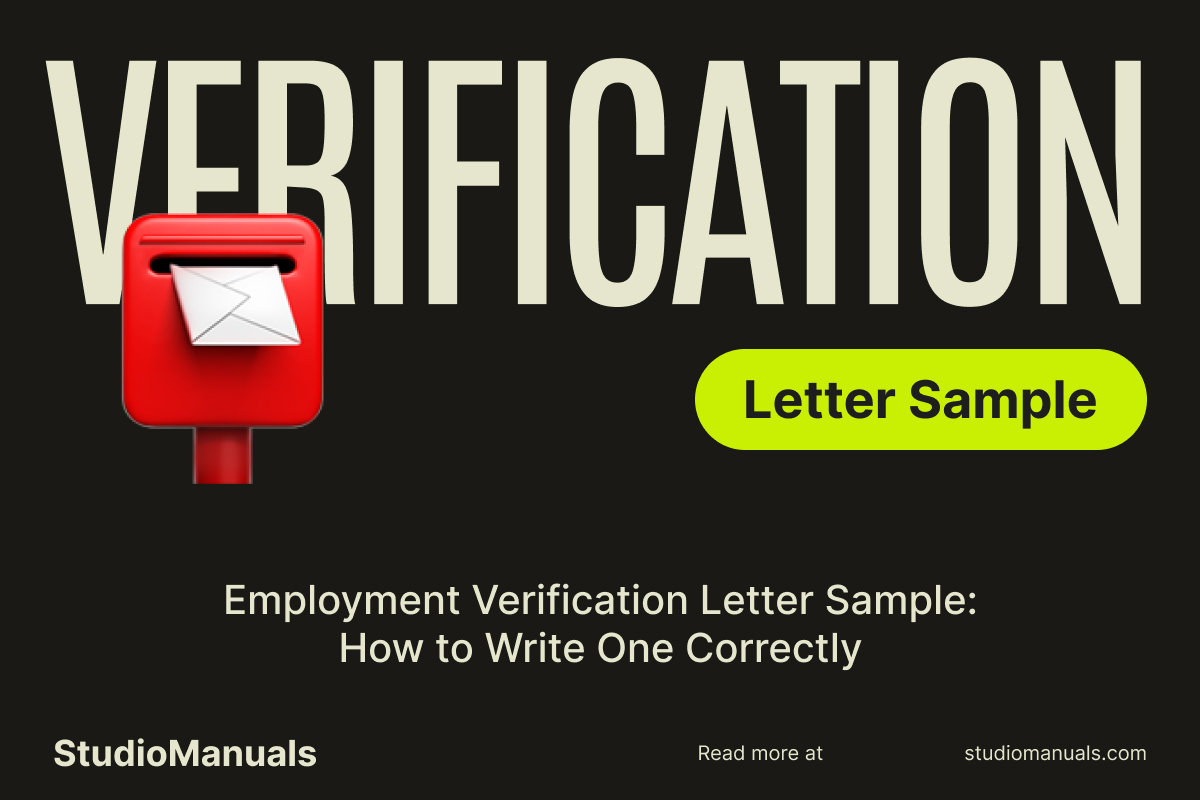Writing an employment verification like Studio Manuals letter might seem like a simple task, but it requires precision to ensure it serves its purpose effectively. Whether you’re confirming a current employee’s status, verifying income for a loan application, or fulfilling a job requirement, a well-crafted letter is crucial. In this article, we’ll walk you through the essential steps, components, and best practices to write an employment verification letter. We’ll also provide a sample to help you get started.
What is an Employment Verification Letter and Why is It Important?
An employment verification letter is a formal document issued by an employer to confirm the employment status of an individual. This letter typically includes details such as the employee’s job title, employment duration, salary, and sometimes, their work responsibilities. It serves as a proof of employment for various purposes like loan applications, visa processes, or background checks.
These letters are important because they provide verified and reliable proof of an individual’s employment status. Whether you’re an HR manager or an employee requesting the letter, it’s vital that the letter is clear, accurate, and professionally written.
Essential Components of an Employment Verification Letter
When crafting an employment verification letter, certain elements are non-negotiable. Here’s what should be included in every letter:
1. Employer’s Information
The letter should start with the company’s name, address, and contact details. This provides the recipient with the context of who is verifying the employment details.
2. Employee’s Information
Next, the employee’s name and job title must be stated clearly. Include the employee’s start date and, if applicable, their current employment status (full-time, part-time, temporary, etc.).
3. Employment Details
The core of the letter will include the employee’s role, length of employment, and salary or income, if necessary. If the letter is for a specific purpose (like a loan), you might need to add further details about the employee’s financial stability.
4. Closing Remarks
End with a formal closing statement, offering to provide further information if needed. This keeps the letter open for any follow-up questions.
Step-by-Step Guide: How to Write an Employment Verification Letter
Follow these easy steps to write a professional employment verification letter:
- Start with your company details: Include your company’s name, address, and contact details at the top.
- Provide a formal salutation: Address the letter to the recipient by their full name, or use “To Whom It May Concern” if the recipient is unknown.
- Introduce the employee: State the employee’s full name, job title, and the date they began working with your company.
- State employment details: Mention whether the employee is currently employed, and include their job duties, employment type (full-time, part-time, etc.), and salary information if applicable.
- End with an offer to provide further details: Close the letter by stating that you are available for additional information if needed.
Common Mistakes to Avoid
While writing an employment verification letter might sound straightforward, several mistakes can undermine its effectiveness:
1. Being Vague
One of the biggest errors is failing to provide clear and specific information. Be sure to include concrete details like employment dates, job titles, and salary amounts when required.
2. Typos and Grammatical Errors
Spelling and grammatical mistakes can hurt the professionalism of the letter. Always proofread your letter before sending it out.
3. Including Too Much Personal Information
Stick to the relevant details. Don’t include unnecessary personal information like the employee’s marital status or health details unless specifically requested for a particular purpose.
When to Use an Employment Verification Letter
Employment verification letters are used in various situations. Here are a few examples of when they might be required:
- Loan Applications: Lenders often require proof of employment to ensure applicants can repay their loans.
- Rental Applications: Landlords may request a verification letter to confirm steady employment and income.
- Visa or Immigration Applications: A letter may be needed as part of the visa process to prove employment stability.
- Background Checks: Companies often request employment verification letters during pre-employment checks.
Employment Verification Letter Sample: A Real-Life Example
Here’s a sample employment verification letter to help you get started:
[Company Letterhead] [Date] To Whom It May Concern, This letter serves as verification of [Employee’s Full Name]’s employment with [Company Name]. [Employee’s Name] has been employed with us since [Start Date] and is currently working as a [Job Title]. [He/She] is a [Full-Time/Part-Time] employee, earning an annual salary of [Salary Amount], which is paid [Monthly/Annually]. Please feel free to contact me at [Phone Number] or [Email Address] if you require further details. Sincerely, [Your Name] [Your Job Title] [Company Name] [Contact Information]
Tips for Employers: Best Practices for Writing an Employment Verification Letter
When writing an employment verification letter, employers should follow these best practices:
- Be Clear and Concise: The letter should be to the point, providing all the necessary details in a clear and understandable manner.
- Use Professional Language: Maintain a formal tone throughout the letter to reflect the professionalism of the company.
- Get the Employee’s Permission: Always get the employee’s consent before disclosing any information related to their employment.
- Offer to Provide More Details: Make it easy for the recipient to follow up with you if they need additional information.
By following these tips, you ensure that your employment verification letter will be both useful and professional. It’s a simple yet essential document that can make a big difference in various personal and business situations.




